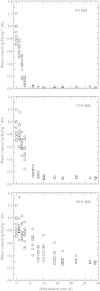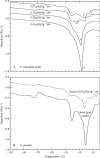Optimal hydration status for cryopreservation of intermediate oily seeds: Citrus as a case study
- PMID: 15781438
- PMCID: PMC4246898
- DOI: 10.1093/aob/mci126
Optimal hydration status for cryopreservation of intermediate oily seeds: Citrus as a case study
Abstract
Background and aims: The purpose of this study was to investigate the basis of the optimal hydration status for cryopreservation of intermediate oily seeds using Citrus as a model.
Methods: The relationships between equilibrium relative humidity (RH), seed water content, presence of freezable water as determined by DSC analysis, and germination percentage after immersion in liquid nitrogen (LN) were investigated in Citrus aurantifolia, C. grandis, C. madurensis and C. reticulata. The relationship between the lipid content of seeds and their unfrozen water content was also investigated.
Key results: Independent of their level of seed desiccation tolerance, the optimal desiccation RH for seed tolerance to LN exposure was 75-80 % in the four species studied. This optimal hydration status always coincided with that at which presence of frozen water could not be detected in seed tissues during the cooling/thawing process. The unfrozen water content of seeds was variable between species and negatively correlated to seed lipid content. Using the present data, those obtained previously in seven coffee species and those reported by other authors for five other species, a significant linear relationship was found between the lipid content and the unfrozen water content of seeds.
Conclusions: This study provides additional evidence that intermediate oily seeds do not withstand the presence of freezable water in their tissues during the cooling/warming process. Moreover, it offers two important applied perspectives: (1) independent of their level of desiccation tolerance, testing germination of seeds of a given oily seed species after equilibration in 75-80 % RH at 25 degrees C and LN exposure, gives a rapid and reliable evaluation of the possibility of cryopreserving whole seeds of this given species; (2) it is now possible to calculate the interval of water contents in which non-orthodox oily seeds of a given species are likely to withstand LN exposure as a function of their lipid content.
Figures






References
-
- Dussert S, Chabrillange N, Engelmann F, Hamon S. 1999. Quantitative estimation of seed desiccation sensitivity using a quantal response model: application to nine species of the genus Coffea L. Seed Science Research 9: 135–144.
-
- Dussert S, Engelmann F, Louarn J, Noirot M. 2004. Inheritance of seed desiccation sensitivity in a coffee inter-specific cross: evidence for polygenic determinism. Journal of Experimental Botany 55: 1541–1547. - PubMed
-
- Folch J, Lees M, Sloane Stanley GH. 1957. A simple method for the isolation and purification of total lipids from animal tissues. Journal of Biological Chemistry 226: 497–509. - PubMed
-
- Ellis RH, Hong TD, Roberts EH. 1990. An intermediate category of seed storage behaviour? I. Coffee. Journal of Experimental Botany 41: 1167–1174.

